An algorithm is a set of instructions that are followed in a specific order to accomplish a specific task.
Algorithms are used in a wide range of applications, from simple everyday tasks like sorting laundry to more complex operations like analyzing medical images.
In this article, we will explore the importance of algorithms in computer science and daily life, as well as the different types and categories of algorithms, how they work, and tips for implementing them effectively.
Types of Algorithms
There are many different types of algorithms, but they can generally be divided into three main categories: sorting, search, and optimization.
Sorting algorithms are used to arrange data in a specific order, such as alphabetically or numerically.
Search algorithms are used to find specific information within a larger dataset, such as a specific name within a phone directory.
Optimization algorithms are used to find the best solution to a problem, such as the shortest route between two points on a map.
Examples of algorithms within each category include Bubble sort for sorting, binary search for search, and linear programming for optimization.
How Algorithms Work
Creating an algorithm involves several steps, including defining the problem, identifying the inputs and outputs, and creating a step-by-step plan to solve the problem.
It is important to consider the time and space complexity of an algorithm, which refer to how long the algorithm takes to run and how much memory it uses.
When choosing an algorithm for a specific task, it is important to consider the trade-offs between different options.
For example, an algorithm with a higher time complexity may run faster on large datasets, while an algorithm with a lower space complexity may be more efficient for smaller datasets.
Common Algorithms in Practice
Algorithms are used in many different fields, including machine learning, artificial intelligence, and data science.
For example, decision trees and random forests are used in machine learning to make predictions, while genetic algorithms are used in optimization problems to find the best solution.
In real-world applications, algorithms are used in a wide range of industries, including finance, healthcare, and transportation.
For example, algorithms are used to detect fraudulent transactions in the finance industry and to analyze medical images in the healthcare industry.
Tips for Implementing Algorithms
Creating an efficient and reliable algorithm requires careful planning and attention to detail.
It is important to thoroughly test the algorithm and ensure that it produces the expected results.
Avoiding common mistakes such as using the wrong data type or failing to account for edge cases can also help ensure that the algorithm is implemented correctly.
Conclusion
Algorithms play a vital role in computer science and daily life, and understanding how they work and how to implement them effectively is crucial.
From sorting and searching to optimization and machine learning, algorithms are used in a wide range of applications and industries.
By following best practices for creating efficient and reliable algorithms and avoiding common mistakes, developers and data scientists can ensure that the algorithms they create are accurate and effective.
Additional resources for learning more about algorithms and their applications include online tutorials, books, and university courses.




